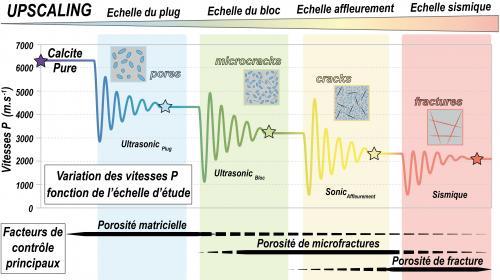Carbonate reservoirs present significant heterogeneities (in terms of types and scales) associated with the biological origin of sedimentsc, as well as the diagenetic transformations that took place when they were deposited or very soon afterwards. This facies-early diagenesis couple thus governs the initial state and evolution of future reservoirs during burial. The purpose of my HDR was to better define this initial state in order to take it into account in geological models.
This research has found direct applications at IFPEN for:
• multidisciplinary and multiscale carbonate modelingd. The idea is to identify the petrophysical and petroacoustic signatures (figure) of
the different facies and the effects of diagenetic alterations, and to demonstrate the different levels of heterogeneity (micro, meso and macroporosity) in these carbonates(1);
• modeling of the mineralogical and petrophysical modifications undergone by a carbonate sediment during early diagenesis, in order to develop a new module for DionisosFlowe 3D stratigraphic modeling software.
For the latter, the work conducted for the HDR led to the development of phenomenological laws incorporating several parameters, such as initial minerology, residence time in each hydrological zone and process kinetics.

The carbonate sedimentary systems studied constitute highly detailed records of environmental changes (climate, sea level, population ecology, etc.), the analysis of which provides keys for understanding and modeling current challenges(2).
a - Descriptive notion of a sedimentary rock based on its appearance and composition
b - Early diagenesis, for which the chemistry of interstitial fluids is directly controlled by the surface environment
c - Which defines the different types of carbonate facies
d - Within the context of the research conducted by C. Bailly (ENS 2019) or the Aquarius consortium
e - Integrated numerical geological model including sedimentary processes
(1) C. Bailly, M. Adelinet, Y. Hamon, J. Fortin, 2019. Geophysical Journal International, 219, 2, pp. 1300–1315.
DOI : 10.1093/gji/ggz365
(2) A. Letteron, Y. Hamon, F. Fournier, M. Seranne, P. Pellenard, P. Joseph, 2018. Sedimentary geology, 367, pp. 20-47.
DOI : 10.1016/j.sedgeo.2017.12.023
Scientific contact: youri.hamon@ifpen.fr





